
Bank holidays
January 1: New Year
March 15: a national holiday, the day when the revolution and war of independence started in 1848
Easter Sunday and Monday.
May 1: Labour Day, a common holiday for the workers of every country since 1891
Whit Sunday and Whit Monday.
August 20: Saint Stephen’s (founder of the Hungarian state) Day, a state, public holiday
According to Act VIII. 1993, from among the three national holidays (March 15, August
20 and October 23) this is the official national holiday.
October 23: a national holiday, the day when the Hungarian revolution and war of
independence started in 1956
November 1: All-Saints’
December 25–26: Christmas
March 15.
October 23.
Other holidays, celebrations and anniversary days
February 25: anniversary day for the victims of communist regimes
April 16: anniversary day for the victims of the Holocaust
June 19: the day of Hungarian Liberty, a memorial day of regaining the country’s
sovereignty, when the last Soviet soldier left the country in 1991.
October 6: a memorial day of the execution of the martyrs of Arad and Lajos Batthyany,
the first Hungarian Prime Minister in 1949.
Besides those listed here, there are other holidays in Hungary as well as follows:
March 8: International Women’s Day, the day of international solidarity with women
The first Sunday of May: Mothers’ Day
The last Sunday of May : Children’s Day
Hungarian etnographic groups
The culture of Hungarian people is homogeneous concerning its basic structure and main features. In spite of that we know of ethnographic groups which more or less differ from our close and distant neighbours. The roots of the establishment of ethnographic groups can be traced back to the time of the Hungarian settlement. The settling tribes differed from one another and these differences were even deepened by the various geographical conditions in the Carpathian Basin and also by historical development.
Hungarian ethnic groups and ethnographical regions in the Carpathian Basin
The Hungarian dialects
In expressing intellectual culture, the language has a relatively significant role and belongs to the Hungarian nation’s ethnographical features. The languages and dialects of certain regions and smaller or larger areas are distinguished from each other by the characteristic words and their meanings as well as their characteristic features in phonetics, morphology and syntax. However, there has never been and there is not such a difference between Hungarian dialects that could impede understanding. Even those living in the most distant Hungarian language areas can understand one another other.
The dialects
folk customs
Customs and traditions accompany the most important events of human life from the moment of birth to that of death. On the other hand, there are almost countless customs throughout the calendar year. Here is a partial list.
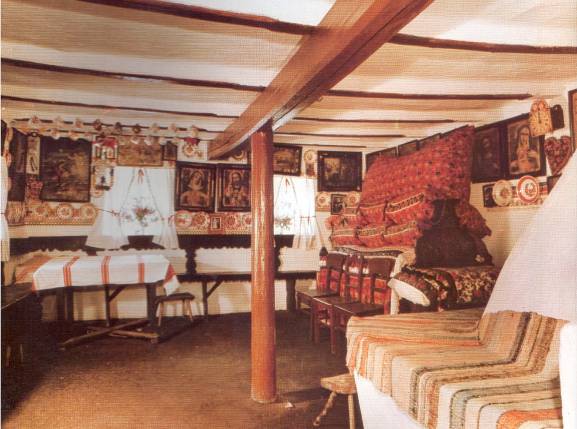
The interior of a traditional house
Weddings are one of the best known and most varied Hungarian customs.
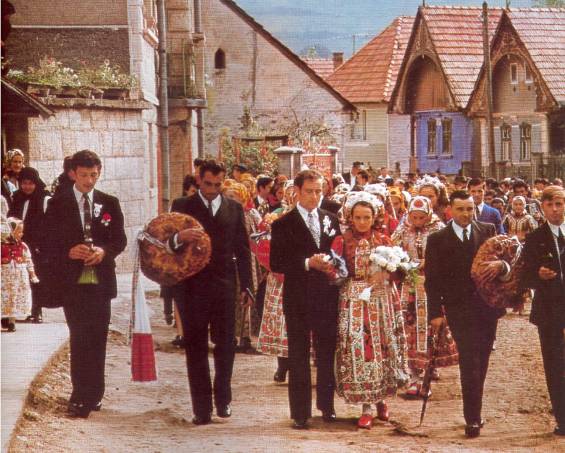
Wedding
Among other things, it is customary to dance with the bride. Generally this is one of the final programmes of the celebration. A plate, a wine bottle and a few glasses are placed in the room, and the dance starts. The best man shouts: ‘The bride is for sale!’ At that moment the guests throw some banknotes onto the plate, and one after the other and dance with the bride. Before handing her over, they drink a glass of wine to the next dancer’s health. This element of the wedding has not only persisted to the present, but is also customary in urban weddings.
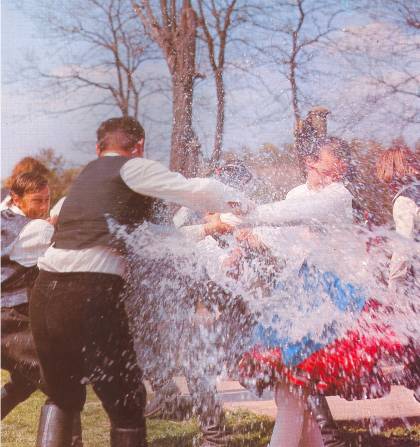
Easter sprinkling
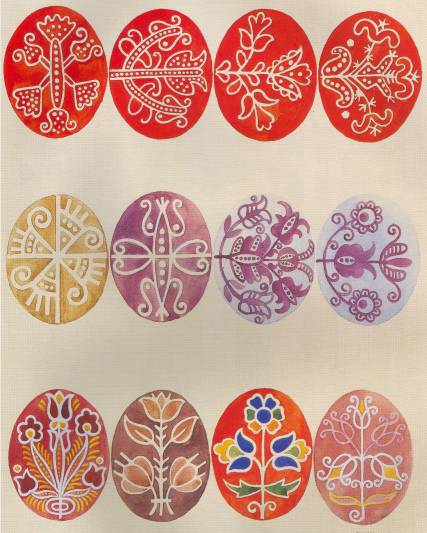
Painted Easter eggs
The customs of the calendar year begin with New Year greetings and continue with Carnival, bidding winter goodbye. There are a lot of customs in connection with Easter; the best known are painting eggs and sprinkling. Both serve as symbols of fertility and at present they are widespread in towns as well. To welcome spring lads set up a may-pole at the beginning of May and at Whitsun the King of Whitsuntide is elected. On Midsummer Day fires are made in certain areas of Hungary to welcome summer. Autumn customs are connected to agriculture, i.e. harvesting crops, therefore they are very different. Perhaps Christmas has the richest traditions. The best known tradition at Christmas is the Nativity play in which children perform the historical birth of Christ in the form of a dramatic play, for which they receive some presents. It is an existing tradition widespread, even today, throughout the whole country. Setting up Christmas trees started in towns and it has become richer in folk elements in villages where some Christmas-tree ornaments are made locally by using crops. Apples, gold-coloured nuts or honey-cakes decorated by sugar icing. Honey-cakes are widely used in urban cultures. Christmas is unthinkable for Hungarian families without either hanging them on the Christmas tree or eating them as part of the special feast.
folk music
The oldest kind of Hungarian folk music is characterised by a pentatonic scale and a recurrent tune structure on the lower fifth. It has a descending melodic line and the songs usually have four lines. These melodic forms unambiguously show an eastern influence. On the one hand they are connected to the music of our linguistic forefathers, on the other hand they show a Turkish influence.
The so-called new type of folk songs shows a clearly western influence. It became widespread in the 19 th century. Its characteristic feature is that the first and the list lines of the melody consisting of four lines are the same. This form of melodies is also closely connected to the old fifth construction of Hungarian-Mari tunes.
A considerable part of Hungarian folk musical instruments were widely used and often made by peasants who had an ear for music. They used several kinds of instruments. Various pipes were easy to make, the flute, the bagpipe, the zither and the cymbal needed more special skills. To tune them, however, was considered as a difficult task.
A good bagpiper was known far and wide, and even dance songs sung by herdsmen were written about him:
He who wants to play the bagpipe,
Needs to know Hell inside out,
Quite some time he must be stayin’,
Mastering his bagpipe playin’.
FOLK DANCES
Certain specified forms of motion also belonged to the characteristic features of various ethnic regions. For example, the walking gait differs; it is not uniform for people from the lowlands and a highland regions. Dancing is a form of motion regulated by traditions and connected to music.
Hungarian dances can be divided into two large categories based on the era of their origin. Concerning their nature, there are ring dances in which each member of the group performs basically the same motions, solo and couple dances.
Such are the round or circle dances (körtánc), also known as ring (karikás) dances, of which some music and lyrics have come down to us, such as:
Ding-ho, way in, ring-ho way in,
Hop in and do the round dance!
Ding-ho, way in, ring-ho way in,
Hop in and do the round dance!
Up in front is justice Johnny,
Dressed in buckled jerkin,
At the back is good wife Mary,
Oakum skirt a-swirlin'.
Most ring dances are performed by girls, usually in between other dances or as an introduction to Sunday afternoon gatherings when the lads break the ring by selecting their own partners.
The new style of dances was brought to perfection in the 19 th century. The best known and the most conservative dance of the time was ‘verbunkos’ (recruiting dance). Spurs were important accessories to this dance. These spurs were not real spurs used by horsemen however, they were small bells tied on the boots of the dancers to provide the rhythm of the dance.
The best known Hungarian dance is the ‘csárdás’ which became common in the second quarter of the 19 th century. The ‘csárdás’ integrated a lot of traditions of various couple dances which became more and more popular starting from the Renaissance. Its music developed from the ‘verbunkos’ on which people danced various forms of ‘csárdás’. In couple dances only men have active roles. On the one hand they repeat the double basic steps and on the other hand they turn round and round in different ways. To remind of the old ring dances two couples join hands now and then and perform a round dance.
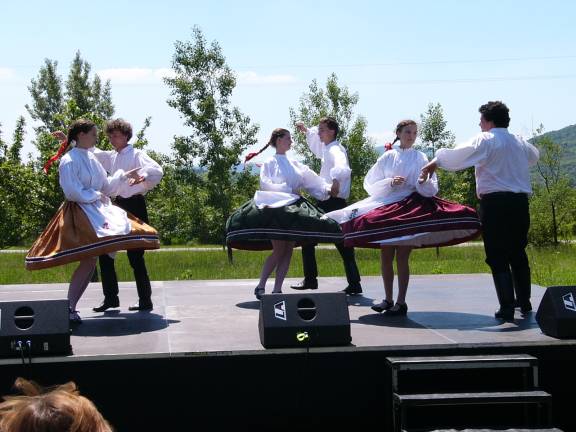
Folk-dance from Bonchida (between Mezõség and Kalotaszeg)
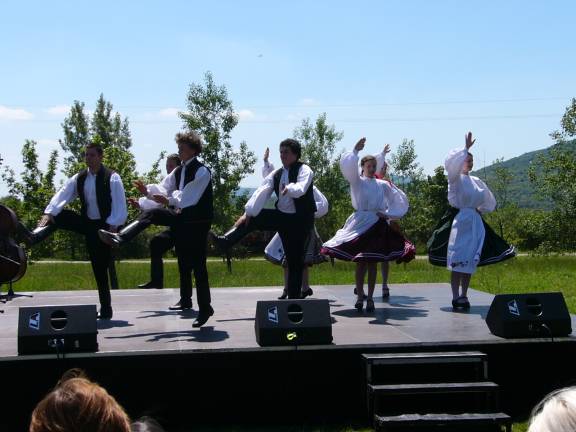
Folk-dance from the Southern Hungarian Great-Plain
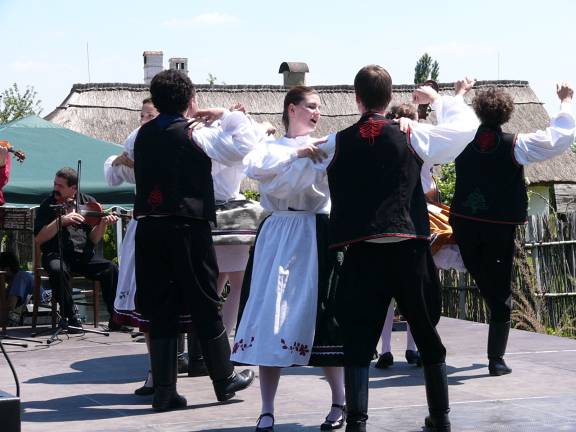
Folk-dance from Hungarian South-Great-Plain
folk costumes
Groups of folk costumes characteristic of certain regions have developed as a result of a long process. The costumes worn by the conquering Hungarians were strongly influenced by the constant connection with their Slavic neighbors. Later on, in the 16 th and 17 th centuries the impact of the conquering Turks was evident and in the following centuries the German influence became more and more dominant. In this way hats for men and coloured ornamental headdresses for young women became more and more important. A characteristic item of Hungarian folk costumes is the shirt for men and women alike, wide white linen trousers for men (formerly used by peasants) and several skirts for women put on one another. For outerwear the ‘szûr’ (long embroidered felt cloak of Hungarian shepherds), the ‘suba’ (wide sheepskin coat) and the ‘ködmön’ (sheepskin waist-coat) became characteristic items. These national costumes were naturally decorated in various ways region by region.
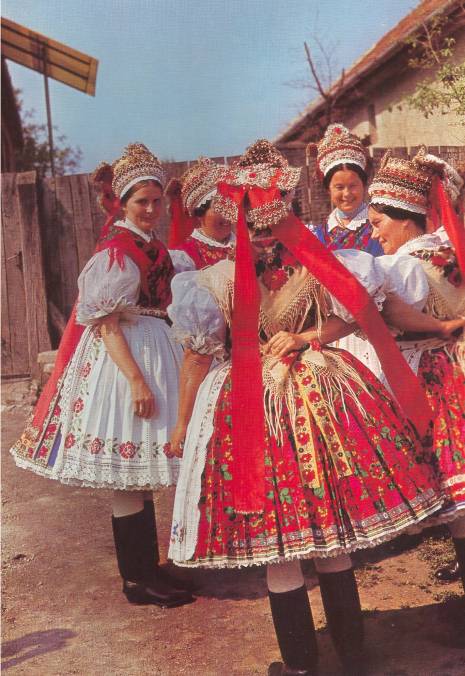
Women wearing their costumes in Kazár, Nógrád County
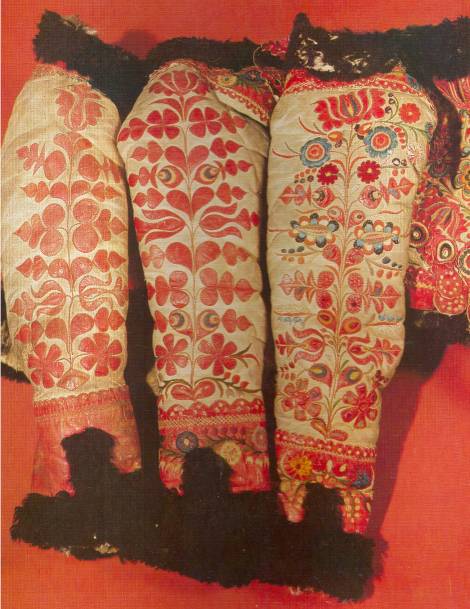
Sleeves of women’s sheepskin jackets
http://www.mek.oszk.hu/02700/02790
What things do people eat here?
You have surely noticed that the fast food popular all over the world is available in the busier places in Hungary. (Hamburgers, hot dogs, barbecued chicken, chips, waffles, etc.) But there are Hungarian specialities for you to try. At street kiosks, at fairs and markets and in holiday resorts ‘lángos’ is sold widely. This is a fiat cake of bread dough which is fried in oil, then sprinkled with salt or spread with sour cream or grated cheese and garlic too for those who want it. Try one, you’ll probably like it In summer you can get freshly cooked com-on-the-cob all over the place. And of course a wide variety of ice cream is available summer and winter.
As for pastries, ‘rétes’ (strudel) is the most popular. Fillings are usually apple, walnut, cottage cheese, poppy seed, sour cherry, even cabbage – which, believe it or not, is delicious. You 're unlikely to see anyone making the strudel pastry nowadays; it's quite an art to stretch the pastry out over a table to get it really thin without breaking it, so people usually buy the ready-made pastry available at most grocer stores!
A popular dessert is ‘somlói galuska’. It will be on the menu of most restaurants. As a rule people love it! It is made of sponge cake, broken up and with walnuts and raisins and maybe other things, then a chocolate cream is spread over that and whipped cream put on top.
‘Dobos’ cake (to be found in any good confectionery) is the invention of a Hungarian pastry-chef, named Dobos. You will recognize it by its shiny caramel top. Another cake to try is ‘Rigó Jancsi’, which is far easier to taste than to describe!
If you have a meal in a restaurant you will find the internationally known dishes everywhere, such as “Wiener Schnitzel” (slice of meat fried in egg and breadcrumbs) or meat (usually pork) fried in butter. But if you want to try something typically Hungarian and you are not frightened of slightly hot dishes, I suggest you ask for ‘paprikás’ or ‘pörkölt’. These are meat dishes prepared with paprika and onions, and can be made from chicken, veal, beef, pork, mutton or even catfish. ‘Galuska’, little yellow dumplings, or ‘tarhonya’, a type of pasta eaten in Hungary are often served with them.
Of Hungarian soups, try ‘gulyásleves’ first. And you1ll see how different it is from the dish served in other countries under the name of Hungarian goulash. Yes, goulash is a soup, which may surprise you, because the dish known as goulash in other countries is more like a ‘paprikás’ with its sour cream, and not a bit like the soup it is supposed to be – which is usually made from beef, potatoes, onions and paprika.
I’ve mentioned fish before, so just to remind you: grilled ‘fogas’ or ‘süllõ’ (zander) is very good, and ‘halászlé’ (fisherman’s soup) is a real Hungarian speciality. Be warned, it may be hot.
After all this food you may get thirsty.
What is there to drink?
To start with the simplest: you can safely drink tap water. Good healthy water flows from the taps all over Hungary, but in the south it's sometimes not quite cold enough.
In most places you’ll see familiar 1 Euro drinks like Coca-cola, Pepsi-cola, Fanta and Schweppes because they’re sold here too. But you should try the Hungarian fruit juices that are made from locally grown fruit (such as sour cherry, apricot, peach, strawberry, apple) with no preservatives. To your health! ‘Egészségedre!’
To finish with, let us learn some of the recipes of some dishes:
Gulyás Soup
360 g cubed beef,
80 g lard,
150 g onion,
15 g paprika,
salt,
garlic caraway seeds,
800 g potato,
140 g green pepper,
60 g fresh tomato,
6 portions of soup pasta
Use meat rich in gelatine (shin-beef, blade or neck). Cube the meat into 1 1/2 - 2 cm pieces. Fry the chopped onion in the melted lard (shortening) until golden yellow. Lower the heat, then add the paprika and stir rapidly. Add meat, keep stirring, and add salt. When the meat is browned and all the liquid is evaporated, add caraway seeds, finely chopped garlic and a small amount of cold water, cover, and braise meat slowly. Stir occasionally and add small quantities of water if necessary. The meat should be braised, not boiled. While the meat is cooking, cube the potatoes, green pepper and tomatoes into pieces 1 cm in size, prepare dough for soup pasta. Just before the meat is completely tender, reduce the pan juices, add the cubed potatoes, let them brown slightly and add the stock, green pepper and tomato. When the potato is almost cooked and the soup is ready to be served, add the pasta, and adjust the quantity by the addition of stock or water.
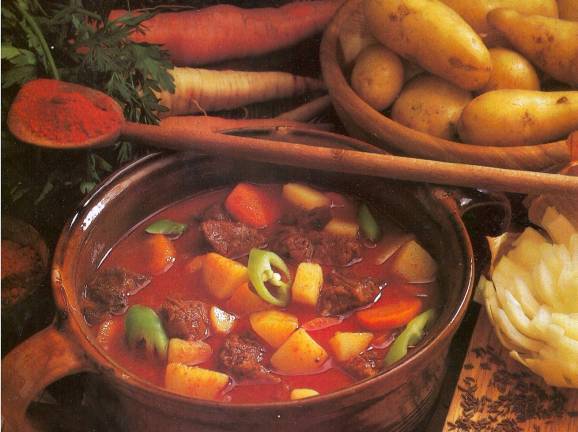
Gulyás Soup
Pörkölt (meat dish)
2,1 kg chicken, or
1.25 kg veal, lamb, beef, pork,
100 g lard,
180 g onion,
20 g paprika,
200 g green pepper,
100 g tomatoes,
salt
This typical product of the Hungarian kitchen is similar to the French ragout. The most often used cuts are the juicy neck, breast, blade or hocks, but other slightly bony cuts may also be used.
Pörkölt sauce should not be thickened. It should be flavourful and just barely cover the meat. The preparation of the different types of pörkölts is very similar, but the ratio of ingredients varies somewhat; as do the flavouring agents.
The chart below will help to summarize the main ingredients of various pörkölts. (Round off measurements according to your discretion!) The boneless meat should be cut into 2-3 cm (approx. 1 inch) cubes. If the meat is on the bone, each piece should weigh about 40-50 g. Cut a chicken into 8-10 pieces.
Onion should be marinated in lard for pörkölt made with beef, mutton or wild game. For any other type of pörkölt, fry onions until light yellow. Reduce heat, add paprika, stir, then add meat and salt. When meat is well browned, add a small amount of water or stock, spices and herbs. Cover and simmer. Stir occasionally. If needed, add more liquid, but very sparingly. Do not boil, it should be almost fried. When the meat begins to soften, add the green pepper and tomatoes cut into cubes, and simmer until the meat is tender. Serve with small galushka dumplings.
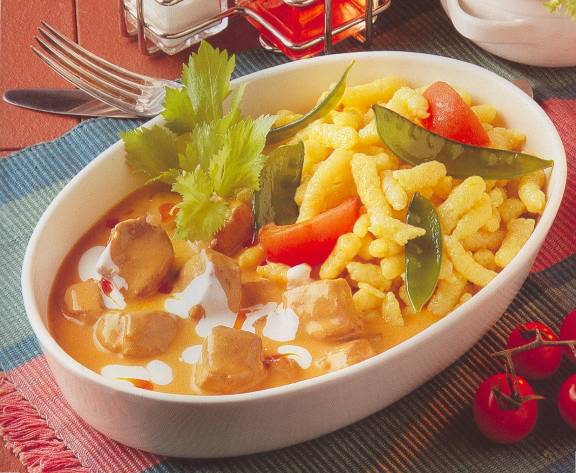
Pörkölt (meat dish) with galushka dumplings
Galushka Dumplings (garnish)
500 g flour,
1 large or 2 small eggs,
salt,
80 g lard
Sift flour into large bowl. Make a hollow in the middle of the flour, crack eggs into hollow, add salt and water in small portions while beating flour, eggs, and water with wooden spoon, creating a semi-soft dough. Dough should easily come off spoon. Boil 3 1itres of salted water in large pot. Heat lard in another saucepan. Use either; a dumpling making tool (similar to a food mill but with larger holes), or a dampened chopping board and a wet knife. Cut dough into strips, then cut into cubes, place into boiling water. (The dumplings vary in size from that of a small kidney bean to that of an unshelled peanut.) As the dumplings boil, they raise to the surface of when fully cooked. Remove with a slotted spoon, rinse and place in a bit of hot lard. Boil the next portion of dumplings. Repeat until all the dough is used up (about 3-4 cooking portions).
These tiny galushka dumplings are a must with the paprikás, pörkölt and tokány.
Simple crepes (Dessert)
9-12 pieces
2 eggs
2 dl milk
240 g semolina flour
2dl milk or soda water, salt or sugar (optional)
100g lard
For thin crepes mix cold milk and eggs with a wire whisk, slowly add flour while mixing. When the dough is very smooth, add more milk or soda water until a cream-like consistency is obtained. If you wish to use a salty filling, add a pinch of salt to the dough. For a sweet filling; add 10 g sugar, this will increase risk of crepes sticking to pan. If the filling is sweet enough, don’t add sugar to dough.
Melt lard in small saucepan. Heat well-cleaned crepe pan. Add 1/2 tsp of lard to the crepe pan and swirl to coat pan. Pour remaining lard back into saucepan. Pour about 1 dl dough into the hot crepe pan, swirl it around, fry over high heat, shaking the pan all the time. The dough should separate from the pan. Fry 5 more seconds, then flip and fry other side. If the crepe breaks, or doesn’t stay together, add an egg or some flour to mixture. If too thick, thin with soda water.
Stir mixture before adding to hot crepe pan – otherwise flour might settle out. If crepe sticks to pan, likely causes are: 1.) too much sugar, 2.) either pan or lard not hot enough, or 3.) inadequate quantity of lard, 4.) crepe pan not properly cleaned before/during the crepe making.
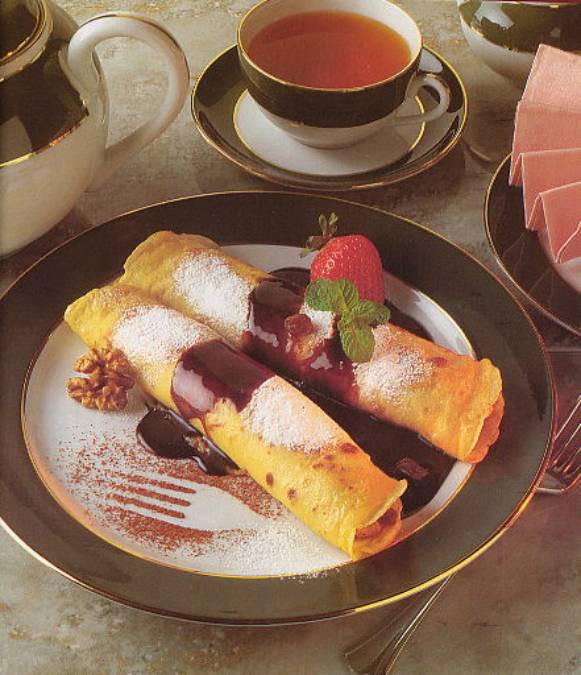
Crepes
LEMON-FLAVORED CREPES
Sprinkle crepes with lemon juice, roll and sprinkle with powdered sugar or powdered vanilla sugar. Option: serve lemon juice and sugar.
CREPES WITH JAM
All kinds of jam can be used. In Hungary apricot jam is the favourite. The apricot jam can be flavoured with apricot brandy. If sour cherries are used, mix sugar and ground walnuts with the cherries.
Crepes with cottage cheese
Soak the raisins (40 g) in rum for 24 hours. Push cottage cheese (400 g) through fine sieve. Beat egg white (2 eggs) until stiff, but not dry. Cream sugar (120 g) and egg yolks until foamy. Beat in vanilla sugar (30 g), sour cream and grated lemon peel. Add cottage cheese and drained raisins. Finally, fold in eggs whites. Place filling in lines on the crepes, and roll crepes.